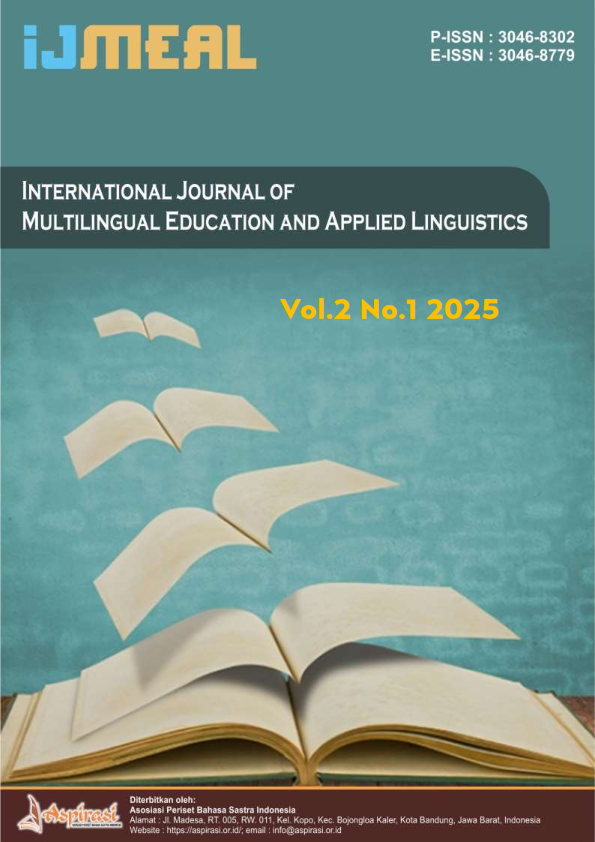Perceptions and Challenges of Using Web-based Platforms for English Language Learning among Senior High Students
DOI:
https://doi.org/10.61132/ijmeal.v2i1.179Keywords:
English Language Learning, Perceptions and Challenges, Web-based platformAbstract
This study explored the perceptions and challenges faced by senior high school students in utilizing web-based platforms for English language learning. Employing a literature review methodology, the study synthesized findings from recent studies to analyze the effectiveness, user experiences, and obstacles associated with digital learning tools in the context of language education. The study highlighted students' positive attitudes towards the accessibility and interactive features of web-based platforms while identifying challenges such as technical difficulties, limited digital literacy, and motivational issues. The review also examined the pedagogical implications of integrating web-based platforms into traditional learning environments, emphasizing the need for teacher training and support mechanisms to maximize learning outcomes. By providing a comprehensive overview of existing research, this study aimed to contribute to the discourse on leveraging technology for language learning in senior high schools and offers insights for future research and policy development.
References
Agnésia, E., Angkat, S., Veronika, F., Manullang, V. M. B., & Sinukaban, E. (2024). Efektifitas pembelajaran bahasa Prancis Niveau A1 berbasis digital web FluentU di Universitas Negeri Medan. Argopuro: Jurnal Multidisiplin Ilmu Bahasa, 5(1), 31–40.
Ali, N. (2023). The Cake application: A mobile-assisted language learning (MALL) to improve English speaking skill. JOLADU: Journal of Language Education, 2(2), 76–83. https://doi.org/10.58738/joladu.v2i2.472
Altynbekova, G., & Zhussupova, R. (2020). Mobile application FluentU for public speaking skills development. SHS Web of Conferences, 88, 02008. EDP Sciences.
Anderson, C. A. (2017). The impact of digital learning tools on reading comprehension and vocabulary acquisition. Journal of Educational Technology, 34(2), 1–15.
Azhima, F., & Halim, A. (2024). The integration of Duolingo in classroom setting: A case study of its impact on English language learning. Riwayat: Educational Journal of History and Humanities, 7(3), 877–890.
Bicen, H., & Kocakoyun, S. (2018). Perceptions of students for gamification approach: Kahoot as a case study. International Journal of Emerging Technologies in Learning, 13(2), 72–93. https://doi.org/10.3991/ijet.v13i02.7467
Bruner, J. S. (1966). Toward a theory of instruction. Harvard University Press.
Cramer, S. (2019). Exploring personalized learning in language education: A case study on Altissia. Language Learning & Technology, 23(1), 45–61.
Deci, E. L., & Ryan, R. M. (2013). Intrinsic motivation and self-determination in human behavior. Springer Science & Business Media.
Dörnyei, Z., & Ushioda, E. (2021). Teaching and researching motivation. Routledge.
Efrizah, D., Sari, I., & Putri, V. O. (2024). The role of parents in increasing children’s English vocabulary in Kelambir V Kebun. JL3T (Journal of Linguistics, Literature and Language Teaching, 10(1), 96–108.
Fadly, Y., Efrizah, D., Purwanto, D., & Aulia, Y. (2023). Enhance English language learning student based on Google Classroom. Jurnal Scientia, 12(3), 3822–3827.
Fauzan, F., & Kasim, U. (2020). Exploring the implementation of Duolingo media for assignment in learning English. English Education Journal, 11(2), 288–301.
Gibson, J. J. (1979). The ecological approach to visual perception. Moughton Mifflin.
Jiang, Y. (2020). The role of gamification in language learning: Enhancing motivation and engagement in digital platforms. Computers & Education, 148, 103799. https://doi.org/10.1016/j.compedu.2019.103799
Kamil, S. A. (2021). Exploring the role of updated technology in university English language classrooms. Psychology and Education Journal, 58(1), 5647–5655.
Kukulska-Hulme, A. (2012). Language learning and technology: A review of recent research. The Modern Language Journal, 96(1), 71–86. https://doi.org/10.1111/j.1540-4781.2012.01292.x
Lee, H. J. (2020). Students' perceptions of digital language learning tools: A case study of high school learners. Journal of Educational Computing Research, 58(6), 1012–1028. https://doi.org/10.1177/0735633120917966
Puentedura, R. R. (2013). SAMR: An evaluation framework for technology integration in education. International Journal of Education & Development, 33(4), 35–47.
Rosida, S., Ritonga, R. S., Losi, R. V., & Ali, N. (2022). Handling children’s speech delay through fables using finger puppets. International Conference on Sciences Development and Technology, 2(1), 282–288. http://creativecommons.org/licenses/by-sa/4.0/
Ryan, R. M., & Deci, E. L. (2000). Self-determination theory and the facilitation of intrinsic motivation, social development, and well-being. American Psychologist, 55(1), 68.
Sari, I., Pulungan, A. H., & Husein, R. (2020). Students’ cognition and attitude in writing descriptive text. Britain International of Linguistics Arts and Education (BIoLAE) Journal, 2(1), 395–404. https://doi.org/10.33258/biolae.v2i1.210
Satar, H. M. (2014). Challenges in digital learning: Perceptions of English language learners in a blended environment. Computers in Human Behavior, 41, 91–99. https://doi.org/10.1016/j.chb.2014.08.019
Stockwell, G. (2010). Using mobile phones for vocabulary activities: Examining the effect of the platform on vocabulary learning. ReCALL, 22(2), 17–37. https://doi.org/10.1017/S0958344009990203
Surendeleg, G., Park, S., & Park, J. (2019). Gamification in language learning: A comprehensive review of its effectiveness and applications. Educational Technology Research and Development, 67(4), 777–799. https://doi.org/10.1007/s11423-019-09717-9
Venkatesh, V., Morris, M. G., Davis, G. B., & Davis, F. D. (2003). User acceptance of information technology: Toward a unified view. MIS Quarterly, 27(3), 425–478.
Yildirim, S. (2017). Technological challenges in language learning: A study on students’ experiences with digital platforms. The Turkish Online Journal of Educational Technology, 16(2), 38–52.
Downloads
Published
How to Cite
Issue
Section
License
Copyright (c) 2025 International Journal of Multilingual Education and Applied Linguistics

This work is licensed under a Creative Commons Attribution-ShareAlike 4.0 International License.





